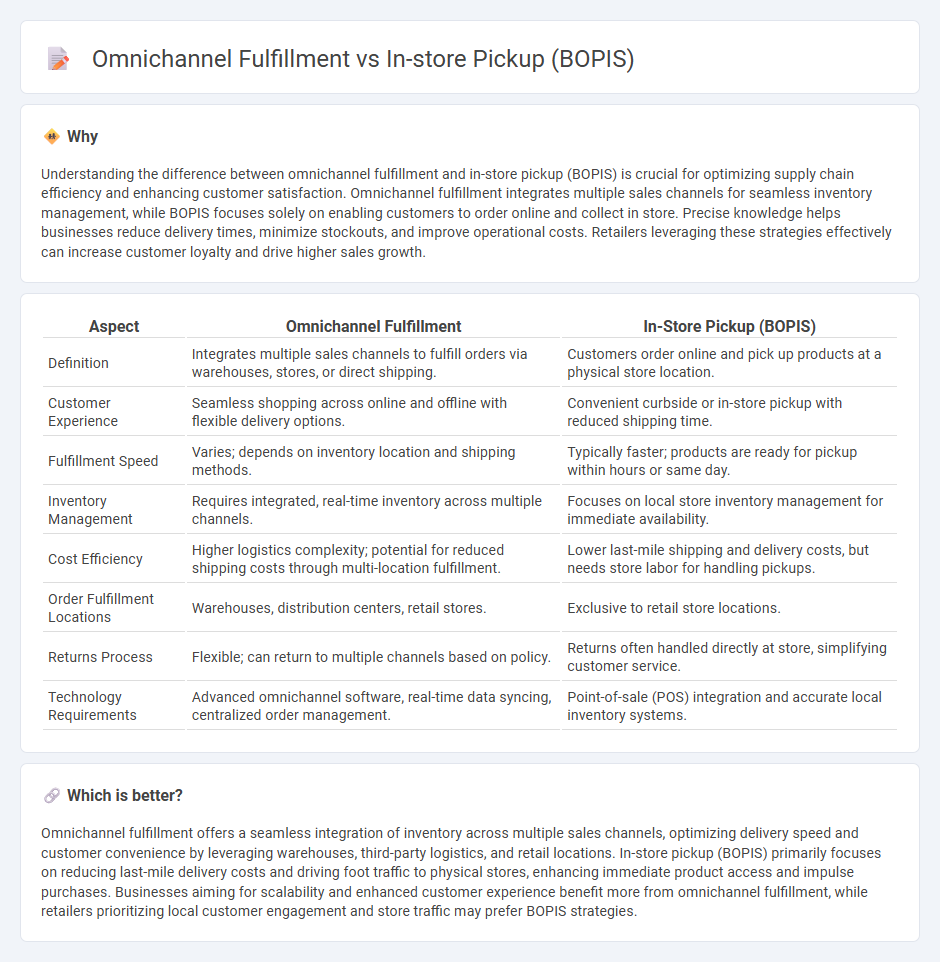
Omnichannel fulfillment integrates multiple sales channels, allowing customers to receive orders through various delivery methods, while in-store pickup (BOPIS) focuses solely on customers collecting purchases directly from physical store locations. Research shows that omnichannel strategies increase customer satisfaction and sales by offering flexible delivery options, whereas BOPIS enhances convenience and reduces shipping costs. Discover how combining these logistics approaches can transform your retail operations.
Why it is important
Understanding the difference between omnichannel fulfillment and in-store pickup (BOPIS) is crucial for optimizing supply chain efficiency and enhancing customer satisfaction. Omnichannel fulfillment integrates multiple sales channels for seamless inventory management, while BOPIS focuses solely on enabling customers to order online and collect in store. Precise knowledge helps businesses reduce delivery times, minimize stockouts, and improve operational costs. Retailers leveraging these strategies effectively can increase customer loyalty and drive higher sales growth.
Comparison Table
| Aspect | Omnichannel Fulfillment | In-Store Pickup (BOPIS) |
|---|---|---|
| Definition | Integrates multiple sales channels to fulfill orders via warehouses, stores, or direct shipping. | Customers order online and pick up products at a physical store location. |
| Customer Experience | Seamless shopping across online and offline with flexible delivery options. | Convenient curbside or in-store pickup with reduced shipping time. |
| Fulfillment Speed | Varies; depends on inventory location and shipping methods. | Typically faster; products are ready for pickup within hours or same day. |
| Inventory Management | Requires integrated, real-time inventory across multiple channels. | Focuses on local store inventory management for immediate availability. |
| Cost Efficiency | Higher logistics complexity; potential for reduced shipping costs through multi-location fulfillment. | Lower last-mile shipping and delivery costs, but needs store labor for handling pickups. |
| Order Fulfillment Locations | Warehouses, distribution centers, retail stores. | Exclusive to retail store locations. |
| Returns Process | Flexible; can return to multiple channels based on policy. | Returns often handled directly at store, simplifying customer service. |
| Technology Requirements | Advanced omnichannel software, real-time data syncing, centralized order management. | Point-of-sale (POS) integration and accurate local inventory systems. |
Which is better?
Omnichannel fulfillment offers a seamless integration of inventory across multiple sales channels, optimizing delivery speed and customer convenience by leveraging warehouses, third-party logistics, and retail locations. In-store pickup (BOPIS) primarily focuses on reducing last-mile delivery costs and driving foot traffic to physical stores, enhancing immediate product access and impulse purchases. Businesses aiming for scalability and enhanced customer experience benefit more from omnichannel fulfillment, while retailers prioritizing local customer engagement and store traffic may prefer BOPIS strategies.
Connection
Omnichannel fulfillment integrates multiple sales channels to provide seamless order processing, enhancing customer experience through flexible delivery options. In-store pickup (BOPIS) serves as a pivotal component of this strategy by allowing customers to order online and collect items directly from physical locations, reducing shipping costs and wait times. Retailers leveraging BOPIS benefit from increased foot traffic and inventory turnover, driving higher overall sales within omnichannel logistics.
Key Terms
Inventory visibility
Inventory visibility is crucial for both in-store pickup (BOPIS) and omnichannel fulfillment, enabling real-time tracking of stock levels across multiple channels. BOPIS relies on accurate inventory data to ensure products are available for immediate pickup, reducing errors and enhancing customer satisfaction. Explore detailed strategies to improve inventory visibility for seamless fulfillment experiences.
Order management system (OMS)
In-store pickup (BOPIS) and omnichannel fulfillment both rely heavily on a robust Order Management System (OMS) to synchronize inventory, process orders, and optimize customer experiences. An advanced OMS integrates real-time data from multiple sales channels, automates order routing, and ensures efficient stock allocation for timely pickup or delivery. Explore how cutting-edge OMS solutions enhance operational efficiency and customer satisfaction in modern retail.
Last mile delivery
In-store pickup (BOPIS) streamlines last mile delivery by allowing customers to retrieve orders directly from physical stores, reducing shipping costs and delivery time. Omnichannel fulfillment integrates multiple sales channels, leveraging inventory across stores and warehouses to optimize delivery speed and customer convenience. Explore how these strategies enhance last mile efficiency in evolving retail landscapes.
Source and External Links
What is buy online, pick up in-store (BOPIS)? - Ingrid - BOPIS means Buy Online, Pick Up In Store, allowing customers to order online and pick up at a store where the retailer fulfills the order either from local inventory or by shipping stock from other locations, offering benefits like faster delivery, reduced shipping costs, and greener online shopping.
How Buy Online, Pickup In-Store Works & Examples (2025) - Shopify - BOPIS lets customers order online and pick up in-store or curbside, with the fulfillment done either from on-site inventory or via transfers from other stores, enhancing convenience by notifying customers when orders are ready.
BOPIS: How To Implement & Improve Buy Online, Pick Up In Store - BOPIS, also known as click and collect or curbside pickup, combines online shopping convenience with instant access by picking up products at a physical location, favored by retailers to retain sales and leverage physical stores.
 dowidth.com
dowidth.com